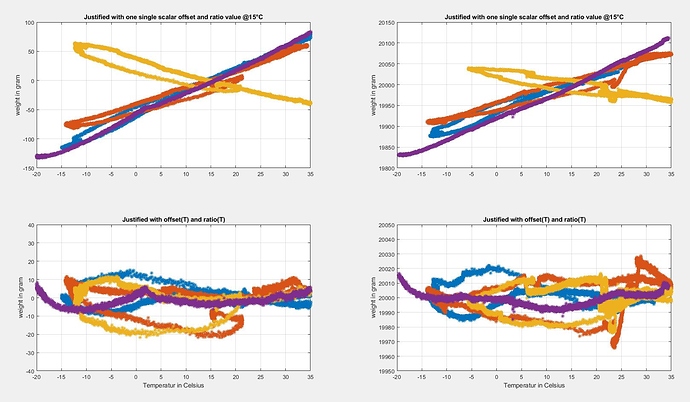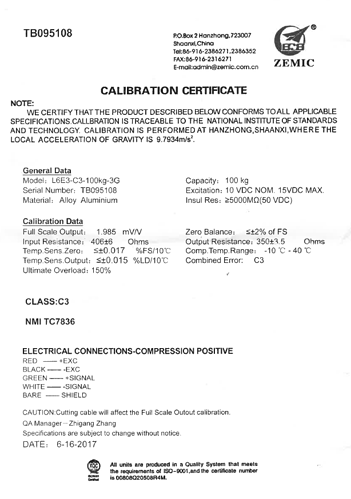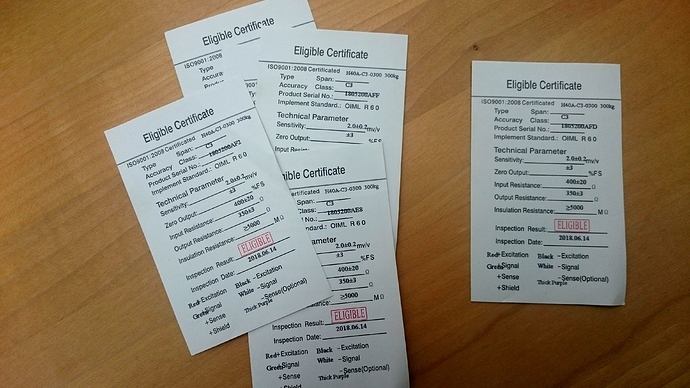Some days ago I read a FB posting about a 4 cell setup with poor reading results. They could solve the problem by a proper grounding. Did you connect the shield of the cable to ground Just brainstorming.
Yes, the shield is connected to GND.
Noch immer keine Antwort von BOSCHE, mittlerweile die dritte freundliche EMail veschickt.
Ich bin kein Großkunde, aber dennoch hätte ich mir eine Antwort erwartet.
Ich bin auf der Suche nach ähnlichen Zellen für meine weiteren Waagen, Bosche möchte ich mir nicht mehr kaufen.
Wer hat Alternativen, wenn möglich aus Europa?
Es gibt Neukigkeiten.
Ich hatte gestern ein Telefonat mit Bosche.
Dort wurde mir erklärt, die 3 Wägezellen sind nicht normal, sondern stammen aus einer anderen Charge.
Normalerweise werden die Zellen vermessen und in Genauigkeitsklassen kategorisiert.
Bei meiner Bestellung wurden die falsche Klasse ausgeliefert. Neben den auf der Homepage angebotenen Zellen gäbe es auch noch die Möglichkeit diese “nicht guten” zu kaufen. Preislich sind diese aber nur ein paar € billiger.
Mir wurde ein Austausch angeboten, ich weiß aber noch nicht ob ich mir das antun soll, der Umbau kostet Zeit - die ich nicht habe :) Weiters habe ich gefragt ob der Temperaturgang reproduzierbar ist, was eindeutig mit ja beantwortet wurde. Somit kann ich mit der individuellen Kompensation gut leben denk ich.
Wägezelle #4 stellt den Regelfall da (wenn bei der Lieferung nichts schief geht).
Einem Unternehmen welches IS0 9001 zertifiziert ist und somit einen Prozess zur Qualitätssicherung haben muss, darf sowas eigentlich nicht passieren.
Tja, ich habe dennoch 4 weitere Zellen dort bestellt, es wurde mir versichert diese werden handverlesen noch einmal überprüft. Ich werde diese aber in meiner “Klimakammer” überprüfen.
Das ist ja eine interessante Aussage, Danke für die Info! Bei den Preisen bei Bosche wundert es mich, dass sie für ein paar EUR weinger dann doch deutlich schlechtere Zellen anbieten.
Wenn #4 der Normalfall wäre, wäre das natürlich klasse! q.e.d. ;-)
Ich habe 4 weitere Zellen bei Bosche bestellt (wieder - H40A 100 kg). Laut Bosche wurden die Zellen handverlesen und in deren Klimakammer überprüft.
Hier das Ergebnis:
links unbelastet, rechts 20kg
oben Rohwerte ohne Temperaturkompensation
unten Temperaturkompensiert
Interessant, die gelbe Zelle hat einen negativen Temp-Koeffizienten, die anderen einen positiven.
Sehr interessant, die Wägezelle 4 ganz oben (violett im Diagramm) von der ersten Bestellung war ja “perfekt” und schwankte über den kompletten Temperaturbereich fast nicht. Die neu bestellten, von Bosche extra ausgemessenen und getesteten, haben einen deutlich breiteren Streubereich – mit ähnlicher Schwankung wie die restlichen drei aus der ersten Bestellung. Alle zwar durch die stabile Linearität gut kompensierbar aber man müsste das halt mit individuellen Koeffizienten machen, wenn man hier verbessern will.
Ja komisch. Ich habe extra für jede Zelle einen Prüfbericht mitbekommen. Dort steht die Zelle entspricht den C3 Standards.
Ich kann zwar mit Temp.Sens Zero und Temp Sens Output nichts anfangen, aber wird schon alles stimmen 
Interessant wäre, wie sieht der Tempgang von “billigen” China-Nachbauten aus? (wobei die ja auch aus China kommt?!)
Wissen wir welche BOSCHE Wägezellen in unseren Systemen verbaut sind?
@Diren
Habt ihr die Messzertifikate bei euch? Können wir da was nachvollziehen, welche Zelle welchem Zertifikat zuzuordnen ist? (Seriennummer)
Das ist ja interessant, dass die Bosche-Zellen von Zemic sind!! ;-)
Wir haben das hier für die BOB-Wägezellen:
Es steht zwar die Seriennummer drauf aber bei allen Zetteln die du auf dem Foto siehst sind die Werte identisch,
Mmmh … schon komisch … dass alle Werte der BOB Wägezellen identisch sind.
Ich hab 4 Prüfzettel mitbekommen, einzig der Wert Full Scale Output (mv/V) ist immer leicht unterschiedlich.
I am a new comer to this forum (congrat. it’s extremely valuable) and I resume this discussion in English because I am not speaking German, sorry. I would like to recap what I have understood from this wonderful thread and ask the community if my understanding is correct. Before joining hiveeyes, I have designed and built a connected beehive but I am stuck with load cell imprecision. I tested two types of load cells: Bath room type (it’s a total disaster) and more robust but china made load cells looking like those of Bosche but exhibiting both temperature drift and creep over time, which make it impossible to properly compensate. I have ordered Bosche H40 and I am reading with high interest the test that Martin has done and the conclusion he has drawn. Here is what I have understood, please correct me if I am wrong:
-
Martin has clearly measured that offset is a linear function of temperature and that the parameters of this linear function are varying by load cell

 and
and  are different with each load cell and they are not part of the load cell specifications
are different with each load cell and they are not part of the load cell specifications -
ratio is defined by putting on the scale a weight of a given, know mass M and reading the ADC output rawDataM corrected by the offset:

-
It is therefore obvious that ratio is also a function of temperature, although not a linear one:

-
In order to measure a weight m with a load cell, the normal procedure is to take a readout of the HX711 (
 ) after applying the weight on the scale and the formula to get the mass m is:
) after applying the weight on the scale and the formula to get the mass m is: 
-
As a conclusion, in order to get a temperature compensated measure, the procedure would be:
-
determine the slope (alpha) and the intercept (offset0) of the offset (which is a linear function of the temperature) by measuring the offset at two different temperature points (as away from each others to minimise error)
-
Apply a known weight of mass M on the scale and take a readout of the ADC
 . This will give the ratio as a fonction of temperature:
. This will give the ratio as a fonction of temperature: 
-
To get a temperature compensated measure of a weight of mass m, put the weight on the scale, take a readout of the ADC (let’s call it
 ) and apply following formula:
) and apply following formula:
where:
-
 is the reading of the ADC when a weight of known mass M is applied
is the reading of the ADC when a weight of known mass M is applied -
 is the reading if the ADC when the mass m to be measured is applied on the scale
is the reading if the ADC when the mass m to be measured is applied on the scale -
 is the intercept of offset(T) (linear function)
is the intercept of offset(T) (linear function) -
 is the slope of offset(T)
is the slope of offset(T) -
T is ambiant temperature in K
My understanding is that the ratio can be calculated with any weight at any temperature with only one measurement.
Is all this correct or do I miss or misunderstand something ?
Thanks much !
-Henri
You have two variables, weight and temperature. Both influence the measurement. Lets assume their function is linear but you know neither offset nor slope. In an ideal case you need at least two measurements to calculate offset and slope.
In reality nothing is linear so you need to make more measurements. Ideally only modifiying one variable (easy with weight, difficult with temperature). Then you get an approximation of the function and then you can calibrate your scale.
In theory, you are probably 100% right. In practice, I would suggest that we can trust (at least to a certain extend) Bosche which is a serious and credible company and I suspect (w/o being sure) that when they say their load cells are compensated in temperature, this is true when you recalculate the initial offset each time you use the load cell, like it’s normally the case with any scale that is not permanently loaded. In other terms, you can calculate the offset at any temperature and then measure a weight, you’ll get the same measure regardless of what this temperature is. Now it you calculate the offset at a given temperature and measure the weight at another temperature, this doesn’t work any more because the offset is varying with temperature.
This is why I believe we only need to measure the slope and intercept of the offset (which seems to be close to a linear function of temperature, based on Martin’s measurements) and apply the formula above to get a reasonably precise temperature compensated measure. I’ll try all that I soon as my set-up is in place.
Ich teste gerade 2 x FiPy in meinem Gewächshaus. FiPy1 mit China-Wägezelle (links) und FiPy2 mit Bosche H40A (rechts).
Daten vom FiPy1: t_i_5 wurde von der Sonne beschienen
Daten vom FiPy2: t_o liegt im Schatten direkt an der H40A
Die Temperaturkompensation der Bosche H40A ist ersichtlich.
Very interesting, thanks much !
May I ask you what was your test setting in term of measure taking ? More precisely, did you reset the offset of the load cell each time you took a measure (seems to be the normal way of operating with any scale that is not permanently loaded) or did you establish the offset once for all and took all your measures with this same offset (when the scale is always loaded, it’s impossible to reset the offset at each measure) ?
Ah - I misunderstood. I thought you were talking generally about measuring. If you have a calibrated scale its of course different. Then the amount of preliminary measurement necessary is inverse proportional to the trust you put into the datasheet of the manufacturer. ![]()
Hello Henri, nice to have you at hiveeyes on board! Welcome! You may have seen this thread with a “nice” collection of the same experiences. Feel free to add details the audience may not know yet!
Good explaind! So in terms of scale calibration factors we have in our code e.g.
const long loadCellZeroOffset = -80186;
const long loadCellKgDivider = -21738;
and the variable loadCellZeroOffset is the bad guy in our game!
One of the most interesting parts in this thread is:
@zmaier used the same settings, the same model of the load cell (“the good one”) and still temperatur effects! And the effect ist different for differen individual load cells. So not the model is the reference for an compensation factor but each cell. That makes building mass hive scales not easy, you have to test and set the compensation factor for every single cell.
My conclusion would be, take a not sooo sensitve load cell and forget about compensating the temperature.
Thanks much Clemens, I appreciate the help and the guidance.
In your experience is the firmness of the frame supporting the load cell an important factor for the measure accuracy ? I am still waiting for the hopefully final double H frame and I am questioning a little bit the frame I am using for testing.





